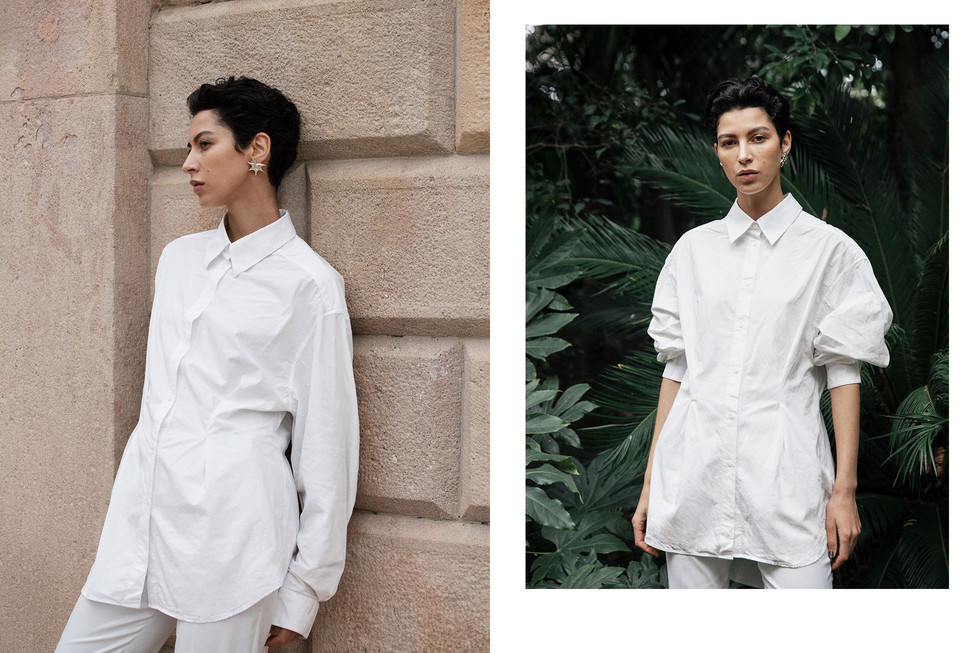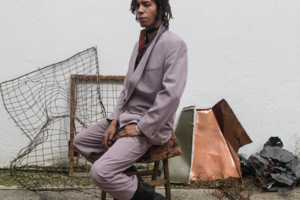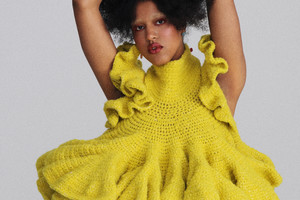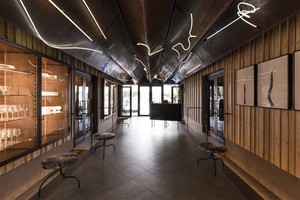Between Touch and Tension: A Conversation with Anna Camner
Written by Natalia Muntean“I’m not a creative person, I just like to paint,” says Anna Camner. A paradoxical statement that is bound to raise eyebrows, considering how Camner’s work vibrates with tension. For Camner, painting is an act of continuous distillation, of “narrowing it down to what feels meaningful,” the Swedish artist obsessing over miniature details and labouring until “there are no question marks anywhere.” While Camner believes “it’s a human need to be creative,” her process is far from effortless. Even after decades, it remains “extremely frustrating,” demanding monastic focus, a surrender to a “trance-like state of mind” she achieves through music.
Camner’s canvases are defined by contradictions - control and abandonment, the synthetic and organic, the weight of light and the lightness of touch - a duality she will explore in her 2025 exhibition, ‘Weight of Light.’
Natalia Muntean: Early in your career, you painted hyper-detailed Gothic flora and fauna - bats, rats, poisonous plants. Now, your work is more abstracted, almost scientific. Was this shift intentional, or an organic shedding of layers? And what has it taught you about your artistic identity?
Anna Camner: Shedding of layers captures it very well. I always had this urge to paint, but when I was young, it was more difficult. I didn’t have my voice yet, so I painted what was around me. I grew up outside Stockholm and spent a lot of time in the forest by the house, walking around, looking at little plants and stuff. For the first years I started painting, I was painting zoomed-in little leaves, plants and details of things happening in nature. With time, old patterns and art historical baggage have gradually fallen away, and I am going in a more personal direction. Now I like to look forward, into the future. I’m much more curious about the future than looking back into my childhood, or art history, or what other artists have done. Over the past twenty years, the process has become less about arriving at a fixed identity, I guess, and more about allowing things to evolve. Patterns emerge, but they do so slowly and without any set destination.
NM: Why and when did this shift happen?
AC: I’m not sure. I started to sneak in plastic at some point into the nature images - little bits of used plastic, or used condoms, into nature. I realised it was more interesting. Then I started doing plastic with bits of nature on it, like it had been lying outside and had little things stuck to it. It was a gradual transition, and I’m not sure why. It’s just a lot more interesting to try and figure out what’s going to happen in the future, especially with things changing so fast.
NM: Where do you get inspiration?
AC: The work itself is like an ongoing dialogue with myself. It's continuous, a little bit like one painting after the other. Sometimes I always go back, like 10 paintings, and I want to return to certain topics, certain patterns. I like it when it's more chaotic, I guess. But with some sort of a sense of order. But you can never predict what that order would be like. I've done those patterns every two years, maybe. Sometimes I return to some themes I've always been working with, and sometimes I find new directions.
NM: Why do you think you go back to themes you've explored and to older paintings?
AC: I don't feel like I'm done. I can keep exploring it because I still find it interesting for the same reasons I always have.
NM: Do you feel you need to excavate it until there's nothing more to find?
AC: No, I can build on it. I can keep building on it.
NM: You work with this tension, the relationship between natural and synthetic materials - do these materials serve as a metaphor for human emotions or desires?
AC:The layers on the bodies and faces amplify or hide gestures and expressions. I like to try to hide the obvious and expose the hidden. Hopefully, the viewer wants to fill in the blank spaces with their interpretations. Due to some sensory differences, the contrast between textures has become a bit of a fixation for me, and this finds its way into my work. When I paint, I often imagine the feeling of touching them. It’s like an obsession, especially with plastics and soft materials. I want to observe and show the different types openly and without assumptions. For me, materials are equal, with no hierarchy between natural and synthetic. It’s all part of the same world.
NM: You also explore touch, both as sensation and communication. How do your paintings translate the intangible experience of touch into visual form?
AC: A painting often starts with imagining how it would feel to touch a material. The layers of different materials become an intensified skin, offering a boosted sense of connection. I play a lot with gloves because hands are very expressive. Facial expressions can be a little overwhelming, but gestures with hands and body language are quite expressive. Especially with gloves, because if you drape something and have layers on the face or body, it’s both hiding parts but also enhancing gestures.
NM: Do you paint your own hands, hands that you know or do you just imagine them?
AC: Often my own. I have gloves of different materials in my studio - soft gloves, latex, different colours and some masks. I work with that.
NM: After avoiding painting during Art School, what made you return to it?
AC: In school, the noise of opinions made it hard for me to stay grounded. Painting requires a kind of vulnerability, and the criticism at school felt too intrusive at the time, so I stopped painting entirely. But I did lots of other stuff - animation, video, everything else but painting. As soon as I graduated, I started doing it again. And then I had to kind of start from the beginning because it was five years of not painting at all, and I had grown up during that time. So it was like starting from scratch, in a way.
Teaching art feels uncomfortable to me, for similar reasons, I believe that finding a voice in painting can’t be explained in steps.
NM: That must have been difficult, to have that pause of five years of not doing it.
AC: I learned other things - art history, art theory, and took some philosophy classes. Some good came out of it - I probably became a little more aware, but also more anxious. The art world is so anxious about themes, contexts, and political ideas - what’s the whole point behind art? It can be a little crippling to have to relate to that all the time.
NM: Do you feel that pressure nowadays that your art has to be political?
AC: No, I’m not pro this “instruction manual” thing some people claim you need to approach art with. I don’t agree with that at all. I think you could approach it like people approach music - we all have a vast reference bank in our heads. I wish more people in the arts would trust their feelings when experiencing it.
NM: What do you think is the role of art nowadays?
AC:I’m not sure. It’s entertainment, of course - entertainment for grown-ups, but there’s not so much fun in it. It’s always themes and trends, and it’s not a free space. I look at fashion documentaries, and there’s so much creativity, playfulness and freedom. I don’t get that feeling often from art. You look at a piece and realise exactly why it’s approved - it’s the right theme, it ticks all the boxes. That’s not so much fun, I think. But maybe it will change.
NM: Your alla prima (wet-on-wet) technique requires both precision and spontaneity, and you’ve also said painting is about “surrendering control.” How do control and surrender coexist in your practice?
AC: The space between intuition and intention is a good place for painting; a lot can happen when that balance clicks. I often picture the motif in a painting like a perfect wave coming at me. The bigger and more technically difficult it is, the more fun it becomes, like trying to stay balanced on a surfboard. I'm not a great painter, and the effort is usually beyond my skill level, but when it's just slightly out of reach, I must focus so much on staying upright that my mind stops asking “why” and just paints. That’s a kind of freedom for me. Painting with your brain isn’t a good thing for me.
NM: But how do you manage to silence it?
AC: It’s a combination of music and making it a little too difficult. Sometimes it feels like I can’t do this. And I do it anyway. That’s the most fun - when it’s that hard and you take a break from yourself. You’re in the painting instead of overthinking.
NM: Can you tell me a little bit about Black Iris and how it came to be, and how it influences your work?
AC: I started it together with my husband a few years ago, during the pandemic. I think it could be a good thing, working together in a way. There's such a strong emphasis on the ideas behind art: politics, social commentary, identity, historical context, and art theory. The visual experience often takes a back seat. With Black Iris, and the symbol of the wide-open pupil, I wanted to suggest that it's okay to look at art with an open mind, and without following any provided manual. The theme of all the exhibitions has been perception, seeing, and just experiencing it. We wanted to bring a sense of freedom when experiencing art.
I’m not sure it has affected me a lot, but I’ve had social anxiety and been very shy in the past, really scared of making contact. It was a big step for me to reach out to these artists. I knew a lot of them, but not all, and I admire all of them. Also, to think about all parts of making an exhibition, it was a good lesson to learn.
NM: Where do you see it going in the future?
AC: For now, it’s just an expensive hobby for me and my husband. Maybe we’ll have to think about whether we can continue, but if we find the right space, maybe we’ll do another exhibition, but it takes quite a lot of time for us to do these things.
NM: How do you pick the artists that are part of it?
AC: We picked everyone when we started, and we haven’t taken in new ones. We wanted to choose artists who have been consistent - a lot of people do one show and have 15 minutes of fame, but not many continue doing good work. We wanted some consistency because that’s kind of difficult in the art world.
NM: Why is it important for you to disrupt this traditional gallery setting?
AC: Not sure I wanted to disrupt it. I've always been really happy working with galleries. I've always done that, and it's been a really good collaboration for me. But there could be other ways of showing art. Gallery spaces with white walls are so beautiful and neutral. But it's also refreshing to put together an exhibition in a rough, worn-down space because it brings in a different kind of energy that interacts with the work visually. And it’s been fun to work with spaces that have been closed to the public, or at least have not been opened in an art context before. It's fun to play with that. The idea was to have complete freedom - you don’t have to work with certain topics, and it doesn’t have to be commercial. We sell pieces, but we don’t take a cut. We’re just trying to create some exhibitions that are memorable or at least enjoyable. The art world can be so serious, like, where did all the fun go? It's fun to do a little breathing space where art can be fun. That was the idea - not to take it so seriously but to create a space of freedom for people.
NM: Last year, you had two exhibitions—one at Liljevalchs (“Cosmology”), and one at Loyal. Can you tell me a little about those?
AC: I also had others in Japan, Los Angeles, and New York. It was a very busy year. The Liljevalchs show was a group show curated by Joanna Sandell and Emil Ivedal. I showed about 11 big oil paintings. It was very feminine—a lot of pink, female bodies.
NM: Do you paint more female bodies?
AC: Yes, because it's a sensitive area, I guess. I identify as a woman, so for me, it’s natural. In a way, they’re self-portraits, mostly. It wouldn’t make sense for me to paint otherwise.
NM: You have an upcoming solo show with the Ståhl Collection in 2025. Can you share any hints about the new direction of this work?
AC: The exhibition is called The Weight of Light. It’s a series of abstract and figurative oil paintings. The motifs are a lot of clay, eyes, silver costumes and odd shapes from my mind. The aim is to catch weightless stuff, like light. The opening is on August 23, and the exhibition runs through January 2026.
NM: Having exhibited in different countries, Japan, the US and Sweden, how do these contexts affect the reception of your art?
AC: The art world is surprisingly similar everywhere - same trends, same references. It’s more fun to show abroad because visiting places is inspiring. But the art world is so similar. It’s crazy how identical the dialogue is.
NM: Last question: What’s a question about your work you’ve never been asked but wish you were?
AC: Oh, that’s difficult. Maybe about my brush obsession. Painters tend to be crazy about pigments, but for me, it’s brushes. I could create the illusion of any colour - colours are just an illusion depending on what’s next to them. But with brushes, you can’t work with a bad one. You have to have the right tools.


















